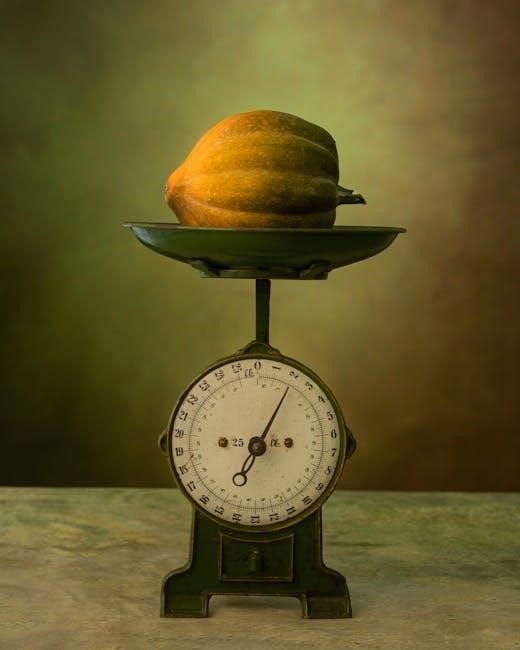The Morse Fall Scale is a widely used tool to assess patient fall risks, helping healthcare professionals plan proactive care and reduce incidents. Its simplicity and effectiveness make it a valuable resource in clinical settings, with the PDF version readily available for easy access and implementation.
Overview of the Morse Fall Scale
The Morse Fall Scale is a reliable tool used to assess a patient’s likelihood of falling in healthcare settings. It evaluates six key variables: history of falling, secondary diagnoses, use of ambulatory aids, IV therapy or heparin lock, gait, and mental status. The scale assigns scores to each variable, with higher totals indicating greater fall risk. It categorizes patients into low, moderate, or high-risk levels, guiding targeted interventions. Widely used for its simplicity and effectiveness, the scale supports proactive care planning and fall prevention strategies. The Morse Fall Scale PDF is a handy resource for healthcare professionals to quickly assess and manage fall risks.
Importance of Fall Risk Assessment
Fall risk assessment is crucial for preventing injuries and ensuring patient safety in healthcare settings. Identifying at-risk individuals allows early intervention, reducing fall-related complications and improving outcomes. Tools like the Morse Fall Scale PDF enable nurses to systematically evaluate patients, fostering a proactive approach to care. Regular assessments, especially during admission, condition changes, or transfers, help tailor safety measures and minimize risks. Effective fall prevention strategies not only enhance patient well-being but also reduce healthcare costs associated with fall-related injuries. The Morse Fall Scale plays a pivotal role in this process, making it an essential resource for healthcare professionals.
Structure of the Article
This article provides a comprehensive overview of the Morse Fall Scale PDF, its components, and its applications in healthcare settings. It begins with an introduction to the scale, followed by a detailed explanation of its history, key variables, and scoring system. The article also discusses how to use the scale effectively, its advantages and limitations, and real-world applications in various care settings. Additionally, it covers where to find the Morse Fall Scale PDF and how to access it, ensuring readers have all the necessary resources. The conclusion summarizes the importance of the scale in fall risk assessment and patient safety.

What is the Morse Fall Scale?
The Morse Fall Scale is a tool used to assess patients’ risk of falling, helping healthcare providers identify and mitigate potential fall hazards effectively in clinical settings.
History and Development
The Morse Fall Scale was developed by J.M. Morse and colleagues in 1989 to identify patients at risk of falling. Initially called the “Scale to Identify the Fall-Prone Patient,” it was designed to predict fall likelihood in healthcare settings. The tool was refined to include six key variables: history of falling, secondary diagnoses, ambulatory aids, IV therapy/heparin lock, gait/transferring, and mental status. Its development marked a significant advancement in fall prevention strategies, enabling healthcare providers to assess risks systematically. Over time, the scale has been widely adopted and remains a reliable tool for reducing fall incidents in clinical environments.
Key Variables Assessed
The Morse Fall Scale evaluates six critical variables to determine a patient’s fall risk. These include a history of falling within the past three months, the presence of secondary diagnoses that may increase instability, and the use of ambulatory aids like walkers or canes. Additionally, it considers whether the patient is receiving IV therapy or has a heparin lock, as these can impair mobility. The scale also assesses the patient’s gait and transferring abilities and their mental status, including confusion or disorientation. These factors provide a comprehensive overview of fall risk, guiding targeted interventions.
Scoring System
The Morse Fall Scale uses a straightforward scoring system to evaluate fall risk. Scores range from 0 to 125, with higher values indicating greater risk. A score of 0-24 suggests no risk, 25-50 indicates low risk, and 51 or higher signifies high risk. Each variable assessed is assigned a specific point value, such as history of falling (25 points) or use of ambulatory aids (10 points). The total score helps clinicians determine the patient’s fall risk level and guide appropriate interventions. This system is designed to be quick and easy to use, taking less than three minutes to complete.
Fall Risk Levels
The Morse Fall Scale categorizes patients into three distinct fall risk levels based on their total score. A score of 0-24 indicates no risk, meaning the patient is unlikely to fall. Scores between 25-50 are classified as low risk, requiring basic preventive measures. Scores above 51 signify a high risk, necessitating immediate and targeted interventions. These clear risk levels enable healthcare providers to prioritize care and implement tailored strategies to ensure patient safety. This system is essential for proactive fall prevention in clinical settings.

Components of the Morse Fall Scale
The Morse Fall Scale evaluates four key components: history of falling, secondary diagnoses, use of ambulatory aids, and IV therapy or heparin lock.
History of Falling
The history of falling assesses whether a patient has experienced a fall during their current admission or within the past three months. This component is scored as 0 if there has been no fall and 25 if a fall has occurred. It is a critical factor in determining the patient’s fall risk, as recent falls indicate a higher likelihood of future incidents. This variable is essential for identifying patterns and underlying causes of falls, enabling healthcare providers to implement targeted interventions. Accurate documentation of fall history is vital for effective risk assessment and care planning.
Secondary Diagnoses
Secondary diagnoses are a key component of the Morse Fall Scale, focusing on medical conditions that may increase fall risk. These include neurological disorders, cardiovascular issues, or other health problems that could impair mobility or balance. Patients with such diagnoses are scored 15 points, reflecting their heightened vulnerability. This aspect of the scale emphasizes the importance of considering underlying health conditions when evaluating fall risks. By identifying secondary diagnoses, healthcare providers can better understand potential contributors to falls and tailor interventions accordingly. This component underscores the holistic approach of the Morse Fall Scale in assessing patient safety.

Use of Ambulatory Aids
The use of ambulatory aids is a critical factor assessed in the Morse Fall Scale. Patients requiring devices like canes, walkers, or wheelchairs receive 5 points, as reliance on these aids may indicate mobility challenges. This scoring reflects the potential for instability or difficulty in moving safely. Assessing ambulatory aid use helps healthcare providers identify patients who may need additional support or modified care plans to prevent falls. This component highlights the importance of addressing physical limitations and ensuring proper assistance to enhance patient safety and independence.
IV Therapy or Heparin Lock
The presence of an IV therapy or heparin lock adds 5 points to the Morse Fall Scale score. This accounts for the increased fall risk due to restricted mobility and potential tripping hazards from IV lines. Patients with IV therapy may have limited movement, making it harder to safely navigate their environment. This factor emphasizes the need for close monitoring and fall prevention strategies in clinical settings to ensure patient safety while undergoing treatment. Proper management of IV devices is crucial to minimize risks associated with falls.
How to Use the Morse Fall Scale

Assess patients upon admission, after falls, or condition changes. Use the Morse Fall Scale PDF guide to score and interpret results effectively for tailored care plans.
When to Assess
The Morse Fall Scale should be used upon patient admission, after a fall, during condition changes, or when transferring to a new unit. Assessments should also occur at least once daily, as part of routine care, to monitor risks effectively. This tool is particularly useful for patients with a history of falls or those with conditions that increase fall susceptibility, such as mobility issues or compromised mental status. Regular assessments ensure timely interventions, promoting safer patient outcomes and reducing the likelihood of falls in clinical settings;

How to Score
The Morse Fall Scale assigns scores to six key variables: history of falling (25 points), secondary diagnoses (15 points), use of ambulatory aids (15 points), IV therapy or heparin lock (20 points), gait or transfer (16 points), and mental status (20 points). Points are summed, with a maximum score of 125. Scores are categorized into three risk levels: 0-24 (low risk), 25-50 (moderate risk), and 51 or higher (high risk). Higher scores indicate greater fall risk. The scale is quick, with most nurses completing it in under three minutes, making it practical for routine use.
Interpreting Results
The Morse Fall Scale results are categorized into three risk levels: low (0–24 points), moderate (25–50 points), and high (≥51 points). Higher scores indicate a greater likelihood of falling. The scale helps identify specific risk factors, enabling targeted interventions. For example, a high score on “history of falling” may prompt closer monitoring, while mobility issues might require physical therapy. Nurses report the scale as reliable and sensitive, with a specificity of 81.6% and sensitivity of 66.7%. Accurate interpretation ensures effective care planning and reduces fall-related injuries, making it a vital tool in clinical settings.
Advantages and Limitations
The Morse Fall Scale is praised for its simplicity and quick assessment, making it highly practical in clinical settings. However, its reliance on subjective factors may limit accuracy in complex cases.
Advantages of the Morse Fall Scale
The Morse Fall Scale offers numerous benefits, primarily its simplicity and ease of use. Nurses and healthcare professionals can quickly assess fall risks, often in under three minutes, making it ideal for busy environments. Its structured approach ensures consistency in evaluations, enhancing reliability. Additionally, the scale identifies specific risk factors, allowing targeted interventions to be implemented effectively. This tool’s practicality and effectiveness contribute significantly to patient safety and care quality, making it a preferred choice in various clinical settings. Its widespread adoption underscores its value in proactive fall prevention strategies.
Limitations of the Morse Fall Scale
While the Morse Fall Scale is a valuable tool, it has certain limitations. Its sensitivity (66.7%) and specificity (81.6%) indicate room for improvement in accurately predicting falls. The scale relies heavily on historical data, which may not fully capture current risk factors. Additionally, it does not account for environmental hazards or patient-specific conditions like compromised mental status, as seen in patients on CIWA protocols. These gaps highlight the need for complementary assessments and continuous updates to enhance its effectiveness in diverse clinical scenarios. Despite these limitations, the scale remains a widely used and practical tool for fall risk assessment.
Where to Find the Morse Fall Scale PDF
The Morse Fall Scale PDF is readily available online. Visit official healthcare websites, academic journals, or trusted medical resources to download the free PDF document easily.
Download Options
The Morse Fall Scale PDF is accessible through various platforms. Official healthcare websites and academic journals offer direct downloads. Some sites require filling out a form to unlock the free resource. Additionally, platforms like Google Scholar and medical resource repositories provide easy access. Ensure to verify the source for authenticity to guarantee you receive the correct and updated version of the Morse Fall Scale. This ensures accurate assessment and effective fall prevention strategies in clinical settings.
How to Access the PDF
Accessing the Morse Fall Scale PDF is straightforward. Visit reputable healthcare websites or academic databases like Google Scholar. Some sites may require completing a brief form to unlock the download. Ensure the source is authenticated to guarantee the document’s accuracy. The PDF is often available for free, providing immediate access to the assessment tool. Direct links are frequently provided on official medical resource pages. This ease of access ensures healthcare professionals can quickly integrate the Morse Fall Scale into their practice, enhancing patient safety and fall prevention strategies effectively.

Real-World Applications

The Morse Fall Scale is widely applied in healthcare settings to assess and prevent patient falls, enhancing safety in hospitals, nursing homes, and home care environments.
Use in Acute Care Settings
The Morse Fall Scale is extensively utilized in acute care settings to proactively identify patients at risk of falling. It is typically applied upon admission, after a fall, or when a patient’s condition changes. The scale’s simplicity and quick assessment process, often taking less than three minutes, make it ideal for busy hospital environments. Nurses assess variables such as history of falling, secondary diagnoses, and use of ambulatory aids to determine risk levels. Scores guide targeted interventions, such as increased supervision or safety measures, to prevent falls and ensure patient safety. This tool is also available as a PDF for easy access and documentation.
Use in Long-Term Care Facilities
The Morse Fall Scale is widely applied in long-term care facilities to monitor residents’ fall risks, particularly those with chronic conditions or mobility challenges. Its use supports ongoing assessments, often conducted during admission, changes in condition, or after a fall. The tool helps caregivers identify high-risk individuals and implement preventive measures, such as safety interventions or environmental adjustments. The availability of the Morse Fall Scale PDF ensures easy access for staff, facilitating consistent and reliable fall risk evaluations. This approach enhances resident safety and reduces the likelihood of falls in these settings.
Use in Home Care
The Morse Fall Scale is increasingly used in home care settings to identify patients at risk of falls, ensuring personalized care plans. Home care providers utilize the Morse Fall Scale PDF to assess risks during admission, after a fall, or when conditions change. Its simplicity allows caregivers to quickly evaluate factors like history of falls and mobility challenges, enabling tailored interventions. This tool is particularly valuable in home environments, where hazards may differ from clinical settings. Regular assessments with the scale help prevent falls and enhance patient safety, making it an essential resource for home care professionals.

Future Directions
The Morse Fall Scale continues to evolve, with periodic updates to enhance accuracy and usability. Future directions include integration with digital health systems and expanded accessibility of the PDF version.
Updates and Revisions
The Morse Fall Scale undergoes periodic updates to enhance its accuracy and relevance in clinical practice. Recent revisions have incorporated new risk factors, such as mental status changes and medication effects, to better align with contemporary patient care needs. These updates ensure the tool remains effective in identifying fall risks and guiding interventions. Additionally, the integration of digital versions, including the PDF, has improved accessibility for healthcare providers. Regular revisions reflect advancements in fall prevention research, ensuring the scale stays current and reliable for nurses and other professionals.
Integration with Technology
The Morse Fall Scale is increasingly being integrated into digital platforms, enhancing its accessibility and efficiency. Electronic health records (EHRs) now incorporate the scale, allowing seamless data entry and analysis. Mobile applications and web-based tools enable nurses to assess fall risks on-the-go, improving timeliness and accuracy. The PDF version remains popular for its ease of use, but digital integration supports real-time tracking and automated scoring, reducing administrative burdens. This technological advancement ensures the scale remains a practical and indispensable tool in modern healthcare settings, promoting better patient safety and streamlined workflows.

The Morse Fall Scale is a vital tool for assessing patient fall risks, enabling healthcare professionals to implement proactive care strategies. Its simplicity, ease of use, and availability in PDF format make it accessible for widespread application. By identifying key risk factors and guiding targeted interventions, the scale significantly contributes to patient safety. Its relevance spans both clinical and non-clinical settings, ensuring comprehensive fall prevention. As healthcare evolves, the Morse Fall Scale remains a cornerstone for reducing fall-related injuries, emphasizing its enduring importance in safeguarding patient well-being.
